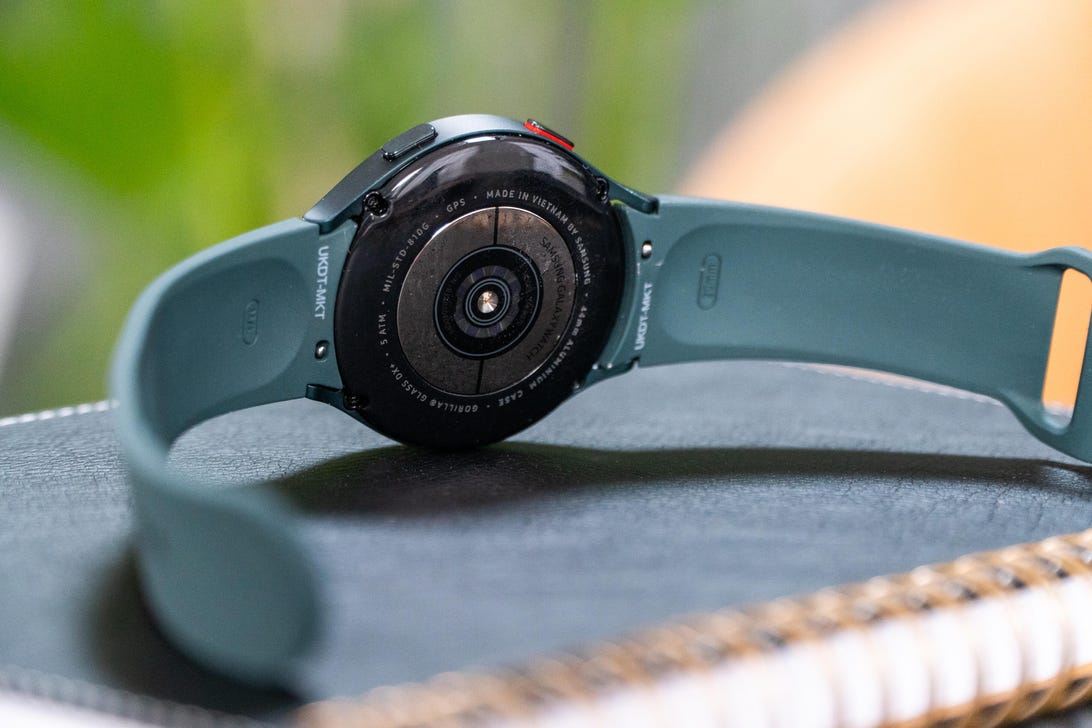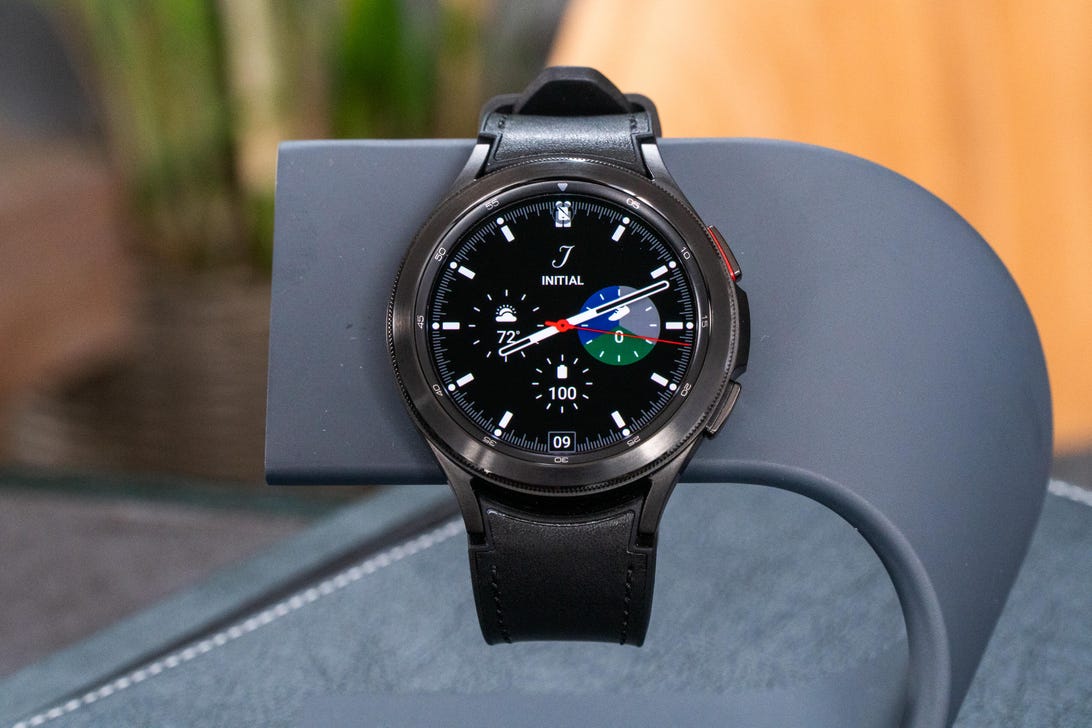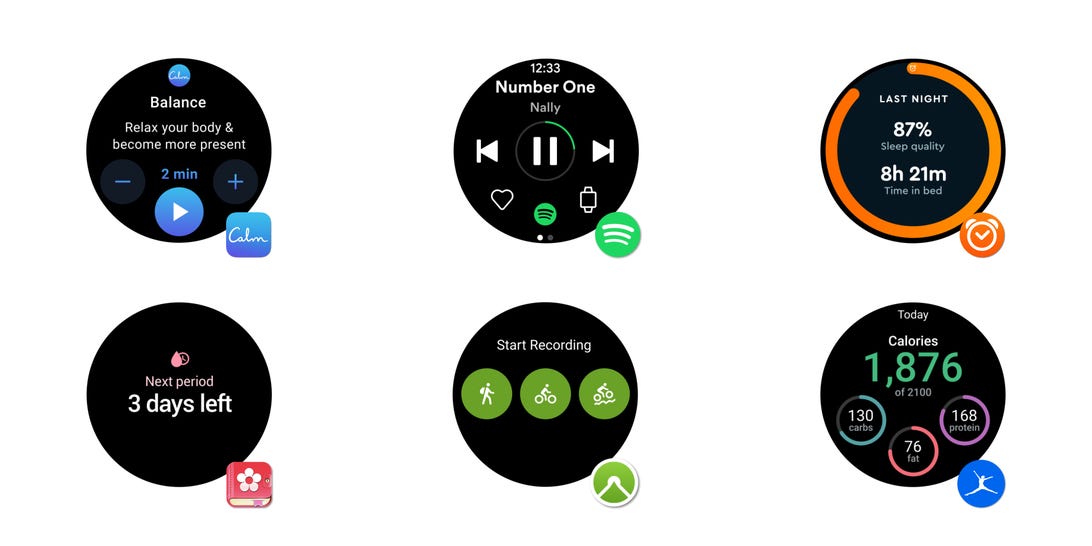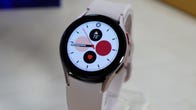Tech
Galaxy Watch 4: Samsung is coming for Apple Watch's crown with Wear OS 3 – CNET

The Galaxy Watch 4 (left) and Galaxy Watch 4 Classic (right) look sharp. And they’re running a whole new Google-Samsung OS.
Drew Evans/CNET
This story is part of Samsung Event, our full coverage of Samsung Unpacked.
There’s one clear go-to smartwatch for iOS: the Apple Watch. But for Android, there hasn’t been a singular option. Will the Samsung Galaxy Watch 4 finally be that watch? At Samsung’s newest folding-phone-focused Unpacked announcement where the latest Galaxy Z Fold 3 and Z Flip 3 phones were unveiled, the company also announced the Galaxy Watch 4 and Watch 4 Classic — which can be preordered now and go on sale Aug. 27. They’re the first Samsung watches to have the Google co-designed Wear OS 3, which isn’t coming to other smartwatches until next year. Following the already-excellent Watch Active 3, will the Galaxy Watch 4 be even better? It certainly looks like it.
Much like previous Samsung watches, there are two designs: a sleeker, less expensive Watch 4 and a more traditional-looking Watch 4 Classic. The latter brings back Samsung’s physically rotating outer bezel and has more traditional watch-like looks and straps. The prices ramp up based on either design ($250 for the aluminum 40mm Watch 4, $350 for the stainless steel 42mm Watch 4 Classic), size (the larger 42mm Watch 4/46mm Watch 4 Classic cost an extra $30) or LTE data compatibility (an extra $50 on top of that). In the UK, the Watch 4 starts at £249, and the Classic at £349. Australian prices are TBD.
Samsung’s watches have always been good. Then there’s also been Fitbit and even Google Wear OS. But Samsung’s Galaxy Watch 4 is looking to tie it all together and reboot the Android watch landscape by finally not having a weird split between Samsung’s watch experience and Google’s.
Promises of better watch-phone connection
The Watch 4’s new Google- and Samsung-developed OS will eventually show up on other smartwatches. But for Samsung’s newest watches, it should mean a more Android-fluid connected experience. Notifications, calls, controlling your phone, syncing with your phone settings: Samsung promises that the Watch 4 will do all this better than previous watches. Samsung’s also promising better battery life and speedier performance. That battery life may still only be about two days, but it’ll be enough to go to bed with and track sleep overnight. Samsung also renamed its watch: The Watch Active name is gone. (Welcome back, Galaxy Watch.)
The Galaxy Watch 4 is only made for Android phones, with no plans for iOS compatibility right now. While previous Wear OS and Samsung watches could pair with iPhones, the Watch 4 is clearly made to be a seamlessly connecting watch for Android (and specifically Samsung) phones. Samsung’s “One UI” philosophy is about syncing wallpapers, designs and settings across phone and watch. Will the watch feel like a seamless extension of the phone? We’ll see when we test-drive one.



The new rear sensor array includes electrical bioimpedance, which promises scale-like body fat/BMI estimates.
Drew Evans/CNET
Health tech: Snore detection and bioimpedance-based body analysis
There are several new health features on the Watch 4 on top of the ones that carried over from the Samsung Galaxy Watch 3. Besides heart rate, blood oxygen and electrocardiogram (and stress-sensing/blood pressure testing that requires calibration with a blood pressure cuff), Samsung is adding a few extras to sleep tracking. Snore detection works using the paired Android phone’s microphone, and the blood oxygen checks now run continuously once a minute overnight (or as a spot-check during the day).
Samsung also added a new sensor to its rear array: an electrical bioimpedance sensor for full-body analysis using a weak electrical current to measure how conductive you are — and therefore showing what you’re made of. This type of sensor tech hasn’t been on recent smartwatches; the last wearable I remember promising bioimpedance was the Jawbone Up 3.
When using the body analysis feature, there will be readouts on your BMI, muscle mass and body water along with body fat percentages, much like some scales. I’m not sure how I feel about that! Samsung Health will use this readout to calculate a range of where your health is compared to optimal levels.
New sensor tech is always a toss-up: Will it work? Will it be useful? We don’t know yet. Samsung is aiming for this to be a comprehensive body analysis tool, which sounds awfully ambitious. Last year, the Fitbit Sense also introduced new electrodermal stress-detection sensors, but I never found them meaningful in my everyday life. Jury’s still out on the bioimpedance features, too.
Samsung Health remains the fitness and health platform default for the Galaxy Watch 4, despite the OS change. But a shift to Google Play for apps and new support for watch face complications should mean a lot of fitness apps make the shift, too. (Complications are basically those little watch-face widgets that show data from other apps, and they’re pretty helpful.) Samsung’s already announced that Strava, Calm and Adidas Running are supported. Spotify’s also supported for on-watch music playback.



See that rotating bezel? It’s back.
Drew Evans/CNET
Boosted specs
The Watch 4’s new processor should be faster than the last Watch 3 (20% faster CPU and 50% faster GPU, according to Samsung) and there’s more RAM (1.5GB) and storage (16GB) than before. That should make animations and app-launching speedier. The Super AMOLED display is sharper: the 1.2-inch 42 and 40mm models have a 396×396-pixel resolution, while the 1.4-inch 44 and 46mm models are 450×450. The watches can also quick charge, gaining 10 hours of battery life on a 30-minute charge.
The rotating bezel is back
Both the Watch 4 and Watch 4 Classic lean heavily on touching the outer rim of the watch to “spin” and navigate: the Watch 4 has a touch-sensitive rim, while the Classic has a physical rotating bezel. Samsung’s also putting touch controls into these watches to allow swipe navigation, much like Wear OS watches. You can choose how to interact.
A few other buttons on the side of the watch control moving back and forth in the interface and can be reprogrammed. One can be pressed and held for Samsung’s Bixby assistant; the other for Samsung Pay. But you can make Google Assistant and Google Pay the go-to apps instead.



Some of the Google apps on the Galaxy Watch 4 have a familiar Google look.
Google apps onboard
Google’s Wear OS 3 being on the Galaxy Watch 4 means it’ll hook into Google Play, but it’s also getting some revamped Google apps. Google’s already committed to new YouTube, Google Maps, Google Pay and Messages apps, which have new designs for Wear OS 3. There are also third-party updates with new Tiles: Calm, Komoot, MyFitnessPal, Period Tracker, Sleep Cycle, Spotify and Strava are among the first to get updates. Google is committing to rolling out more updates over time, meaning that both Samsung and Google should be keeping this watch full of apps.
But you’re stuck with Bixby for now. Samsung’s voice assistant is still the default on the watch, which comes up when pressing and holding the top button. Google Assistant isn’t available at the moment, which is frustrating — that’s one of the top things I’d want to access on a Google-connected watch.
Could this be the best Android watch?
The Galaxy Watch 4 looks like the ultimate fusion of a Samsung watch with Google watches — and that could be a winning formula for using Google Maps, connected phone features and third-party fitness apps on Google Play, which is the Galaxy Watch 4’s default app store. It should be the hardware-boosted Google watch that we’ve been waiting years for. The software interface seems exactly like what you’d expect: part Samsung, part Google. But is it worth waiting to see how it works out, or should you just go for this first model? Hard to tell, since it’s the first of its kind.
It’s not surprising that Samsung’s new health features and its new OS aren’t coming to older Samsung watches for now. Some of them might, but expect this to largely be a clean break and a reboot. And we also don’t really know how many of the Galaxy Watch 4’s features will carry over to the rest of Google’s future Wear OS 3 watch lineup, which will include watches from Mobvoi, Fossil and eventually Fitbit.
Those Wear OS 3 watch updates won’t come to those other watches until 2022, which makes the Galaxy Watch 4 the only new Google-connected Wear OS 3 watch this year. For that reason alone, it could very well be the best Android watch of the moment. As to how it actually feels and works? We’ll have full hands-on impressions and a review in the days ahead… but the Galaxy Watch 4 looks extremely promising for any Android phone owner who wants a much more hooked-in watch.
Tech
Nothing Ear And Nothing Ear (a) Earbuds Are 1st With ChatGPT Integration – Forbes


London-based Nothing Tech has just launched new earbuds, two pairs, in fact. The Nothing Ear and more affordable Nothing Ear (a) have just gone on sale—you can read Forbes contributor Mark Sparrow’s review of both pairs here. And now, the company has announced a cool new feature: and industry-first integration with ChatGPT. It comes with strings, though.
The new earbuds have just been announced and are available to pre-order from nothing.tech now and go on sale from Monday, April 22. If you’re in London, and you want to be among the very first to get the earbuds, you can snap them up in the Nothing Store Soho a little bit sooner, from Saturday, April 20 (click-and-collect is available).
From launch, the company said, “it will enhance its overall user experience with industry-first ChatGPT integrations in its audio and smartphone products.”
Nothing goes on that it wants “to advance consumer tech products’ transition to AI, as well as simplify and enhance the user experience.”
It means users will be able to pinch the earbud to directly speak to ChatGPT to ask questions and hear responses in the earbuds. Nothing is also introducing new elements to Nothing phones, such as widgets which make it easy to talk to ChatGPT on the handsets. Other features include being able to send screenshots directly to ChatGPT and a clipboard shortcut for sending text.
So, what are the catches?
Although the Bluetooth new earbuds will work with any iPhone or Android phone, and there are dedicated Nothing apps for each platform, the ChatGPT integration is more limited for now.
function loadConnatixScript(document)
if (!window.cnxel)
window.cnxel = ;
window.cnxel.cmd = [];
var iframe = document.createElement(‘iframe’);
iframe.style.display = ‘none’;
iframe.onload = function()
var iframeDoc = iframe.contentWindow.document;
var script = iframeDoc.createElement(‘script’);
script.src = ‘//cd.elements.video/player.js’ + ‘?cid=’ + ’62cec241-7d09-4462-afc2-f72f8d8ef40a’;
script.setAttribute(‘defer’, ‘1’);
script.setAttribute(‘type’, ‘text/javascript’);
iframeDoc.body.appendChild(script);
;
document.head.appendChild(iframe);
loadConnatixScript(document);
(function()
function createUniqueId()
return ‘xxxxxxxx-xxxx-4xxx-yxxx-xxxxxxxxxxxx’.replace(/[xy]/g, function(c) 0x8);
return v.toString(16);
);
const randId = createUniqueId();
document.getElementsByClassName(‘fbs-cnx’)[0].setAttribute(‘id’, randId);
document.getElementById(randId).removeAttribute(‘class’);
(new Image()).src = ‘https://capi.elements.video/tr/si?token=’ + ’44f947fb-a5ce-41f1-a4fc-78dcf31c262a’ + ‘&cid=’ + ’62cec241-7d09-4462-afc2-f72f8d8ef40a’;
cnxel.cmd.push(function ()
cnxel(
playerId: ’44f947fb-a5ce-41f1-a4fc-78dcf31c262a’,
playlistId: ‘aff7f449-8e5d-4c43-8dca-16dfb7dc05b9’,
).render(randId);
);
)();
The earbuds must be paired with a Nothing handset. From today, the feature works with the premium model, the Nothing Phone (2), providing it’s running the latest software. The earlier Nothing Phone (1) and more recent, more affordable model, Nothing Phone (2a) will need to wait for a software update, which Nothing says is “coming soon”.
Also coming in the future is compatibility with earlier Nothing earbuds, that is the Ear (1), Ear (2) and Ear (Stick).
The new earbuds are very keenly priced. Ear costs $149 (£129 in the U.K.), while Ear (a) is $99 (£99 in the U.K.). Both pairs have active noise-cancelling, which is not commonplace at this price point. The more expensive Ear has a wireless charging case and a feature to create a personal sound profile. Both pairs come in black and white finishes, with Nothing’s trademark transparent design in the earbuds and charging case. But the Nothing Ear (a) has an eye-catching extra: a tremendous yellow-finish option.
Tech
U of T Engineering PhD student is working to improve the sustainable treatment of Ontario's drinking water – U of T Engineering News – U of T Engineering News


Growing up in a small neighbourhood in Cameroon, Maeva Che (CivMin PhD student) was aware of challenges of accessing clean drinking water.
“Experiencing that exposure to water issues and challenges with sustainable access to safe drinking water ignited my interest in water treatment,” Che says.
Che’s drive to improve water quality around the globe brought her to the Drinking Water Research Group (DWRG) at University of Toronto’s Faculty of Applied Science & Engineering, where she is researching innovative solutions to address local water issues.
Che is working under the supervision of Professor Ron Hofmann (CivMin), who is a member of the DWRG. Her research focuses on removing unpleasant taste and odour compounds in Ontario’s drinking water by promoting the biodegradation of these compounds through granular activated carbon (GAC) filtration.
The project is supported by a five-year Natural Sciences and Engineering Research Council of Canada (NSERC) Alliance grant called Advanced and Emerging Issues in Drinking Water Treatment.
GAC filtration is a water treatment process that uses granular activated carbon, which is made from organic materials that are high in carbon, such as wood, coal or coconut shells. These materials are heated in the absence of oxygen through a process known as pyrolysis and prompted chemically or physically to produce the activated carbon. The activation enhances the material’s adsorption properties, making it productive to remove contaminants from water.
While GAC filtration is an effective treatment process, its adsorptive capacity is limited. The adsorptive capacity of GAC is expected to become exhausted after about three years in service and drinking water treatment utilities must replace the GAC. Aside from the inconvenience, replacing GAC is costly.
Che is working on alternative ways to remove contaminants using GAC filtration, specifically through biodegradation. When the filtration has been in service for a while, there is the growth of micro-organisms on the GAC, which can be useful for removing contaminants.
“Think of biodegradation as the useful bacteria on the GAC feeding on the contaminants in the water, thereby removing them,” says Che.
“If the GAC has enough good bacteria that is biodegrading the compounds, the GAC may not need to be replaced when its adsorptive capacity becomes exhausted. This can extend the filter’s lifetime, resulting in cost benefits for treatment utilities.”
In other words, biodegradation can potentially enhance the performance of GAC filters.
Che and the DWRG will collaborate with water treatment plants to determine methods that can enhance the biodegradation of taste and odour compounds within their GAC filters.
Currently in its initial phase, the project is taking place alongside the Peterborough Utilities Group’s drinking water treatment plant, where Che is conducting pilot-scale filtration studies with support from the Peterborough Utilities Commission. They plan to extend this research to other partner treatment plants in the future.
Working with various water treatment plants across Ontario, Che will also assess the effectiveness of GAC filters in removing non-traditional taste and odour compounds, which are not commonly monitored.
To achieve this, she’ll evaluate filter performance for two common taste and odour compounds — 2-methylisoborneal and geosmin — and eight additional non-traditional compounds that can cause taste and odour events. This involves collecting GAC and water samples from the plants and conducting lab-scale filtration tests, called minicolumn tests. This test, developed by the DWRG, allows to differentiate between adsorption and biodegradation in GAC filters.
Minicolumn tests provide crucial insights into the performance of the GAC filters in terms of the adsorption and biodegradation of contaminants. To distinguish between these mechanisms, researchers use parallel minicolumns. One minicolumn operates under conditions where the biological activity of micro-organisms is suppressed, which isolates the adsorption process. The second minicolumn operates without biological suppression, allowing both adsorption and biodegradation to occur.
“Many plants are unaware of their filters’ performance for other compounds, aside from the two common ones, that also contribute to taste and odour events in water. Our project, therefore, plays a crucial role in expanding the understanding of this,” Che says.
Project partners include the Ajax Water Supply Plant and the Barrie Surface Water Treatment Plant.
The DWRG is made of approximately 30 graduate students, post-doctoral fellows, research managers and associates who collaborate with local, national and international industry and government organizations to address a wide range of projects related to municipal drinking water.
Che credits her experience as a master’s student with the research group as a major factor in her decision to pursue a PhD at the University of Toronto.
“During my master’s degree with the DWRG, I worked on projects that improved drinking water quality, gaining hands-on experience at treatment plants. Seeing the results of my research reinforced my decision to pursue my PhD here,” Che says.
Ultimately, Che hopes to make a significant impact in the field — and the DWRG provides opportunities to achieve this, with a supportive community of researchers and supervisors.
“My goal is to continue researching and developing sustainable solutions for drinking water treatment that benefit communities in need,” she says.
Tech
Huawei's latest flagship smartphone contains no world-shaking silicon surprises – The Register


When Huawei debuted its Mate 60 smartphone in mid-2023, it turned heads around the world after teardown artists found it contained a system-on-chip manufactured by Chinese chipmaker Semiconductor Manufacturing International Corporation (SMIC) using a 7nm process.
SMIC was thought not to be able to build that sort of thing. So while the Mate 60 didn’t differ markedly from every other modern smartphone, its very existence called into question the effectiveness of US-led efforts to prevent advanced chipmaking tech reach the Middle Kingdom.
Much speculation has therefore concerned what Huawei would deliver next, and this week the world got its answer – in the form of the Pura 70.
Chinese media report that early users of the device have posted details of its innards, naming the SoC as Kirin 9010 with four efficient cores running at 1.55GHz, half a dozen performance cores at 2.18GHz, and a couple of high-performance cores zipping along at 2.30GHz. All cores are Arm v8. A third-party spec sheet suggests it’s a 7nm chip – meaning Chinese chipmakers appear not to have made another unexpected advance.
Early tests suggest it outperforms the Kirin 9000 found in the Mate 60, but independent assessments are yet to emerge. The crowdsourced evaluations currently available are sometimes dubious.
What we can say with confidence is that the Pura 70 has a 6.6-inch OLED display with 120Hz refresh rate and resolution of 2,760 x 1,256. It has 12GB RAM aboard, and buyers can choose from 256GB, 512GB, or 1TB of storage.
The three rear-facing cameras on the base models can capture 50, 12, and 13 megapixels apiece.
The Pura range derives from Huawei’s P-Series handsets that stretched from the midrange to the low-end of premium, but are now focussed – pardon the pun – on photography enthusiasts. The device comes on four variants, each priced to match the four editions of Apple’s iPhone 15.
The screen on the high-end “Ultra” model grows to 6.8 inches and 2,844 × 1,260 pixels, with two rear cameras that shoot at 50 megapixels and one at 40. One of the 50MP snappers is retractable, to enhance its zooming powers.
Importantly, all models of the Pura 70 run HarmonyOS 4.2 – Huawei’s not-Android operating system.
China is all-in on HarmonyOS as the nation pursues indigenous alternatives to Western tech. In recent weeks Chinese media and government agencies have noted the growing proliferation of native HarmonyOS apps, trumpeting that developer enthusiasm for the platform means local buyers now have a more patriotic alternative.
That alternative appears to be welcome: after the debut of the Mate 60, analyst firm IDC saw Huawei’s smartphone market share improve by 36.2 percent. ®
-
Media19 hours ago
DJT Stock Rises. Trump Media CEO Alleges Potential Market Manipulation. – Barron's
-
Media21 hours ago
Trump Media alerts Nasdaq to potential market manipulation from 'naked' short selling of DJT stock – CNBC
-
Investment20 hours ago
Private equity gears up for potential National Football League investments – Financial Times
-
Real eState12 hours ago
Botched home sale costs Winnipeg man his right to sell real estate in Manitoba – CBC.ca
-
News18 hours ago
Canada Child Benefit payment on Friday | CTV News – CTV News Toronto
-
Business20 hours ago
Gas prices see 'largest single-day jump since early 2022': En-Pro International – Yahoo Canada Finance
-
Art23 hours ago
Enter the uncanny valley: New exhibition mixes AI and art photography – Euronews
-
Business12 hours ago
Dow Jones Rises But S&P, Nasdaq Fall; Nvidia, SMCI Flash Sell Signals As Bitcoin's Fourth Halving Arrives – Investor's Business Daily






